Last Updated on August 26, 2023
Confused between Zoom and Microsoft Teams?
In this article, we will talk about Microsoft Teams and Zoom and how their features (user interface, security, and more) compare.
Let’s get started.
Table of Contents:
What is Zoom?
Regarding virtual events, seminars, and video conferencing, Zoom is always one of the software that gets mentioned.

That’s because Zoom is the most popular video conferencing software built with a simple user interface.
Most people that need to meet online usually start with Zoom simply because it’s known for its generous free version.
By the way, a lot has changed with Zoom and you will notice that it has started to take its competition with Microsoft Teams seriously.
Sign up for exclusive updates, tips, and strategies
What is Microsoft Teams?
Microsoft Teams gained popularity during the pandemic as more businesses flocked to it as the go-to virtual workplace.
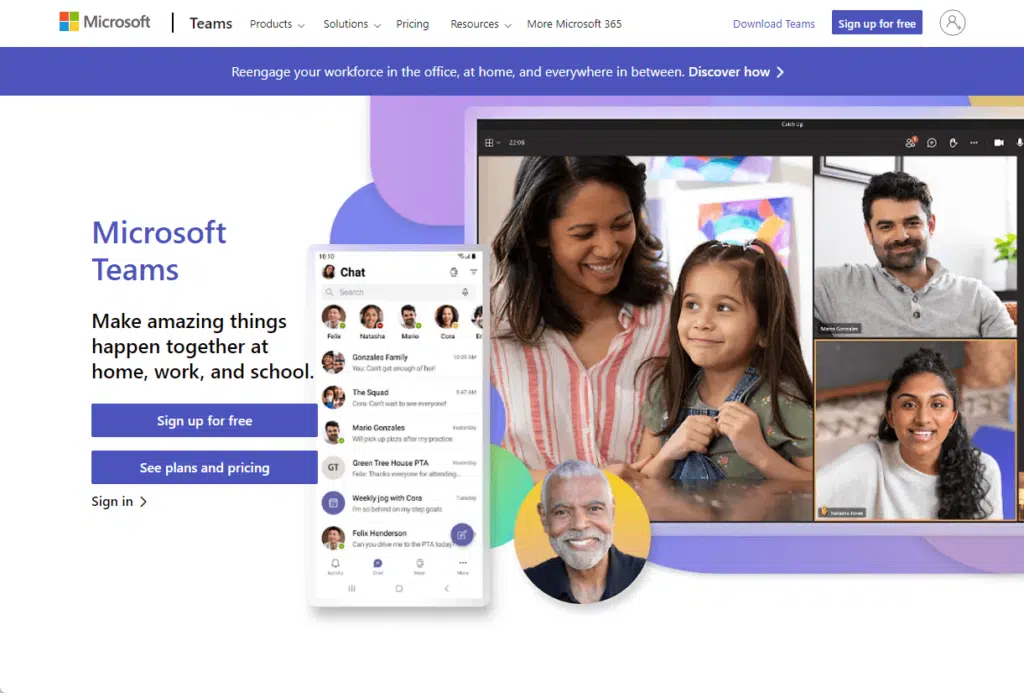
It’s basically a platform that combines virtual meetings, calls, file sharing, and collaboration — basically becoming a workplace.
Microsoft Teams is more than a tool for video conferencing as Microsoft actually positions it as an app hub for various Microsoft tools and apps.
Note: For an overview of the different Microsoft 365 tools and apps, Microsoft 365 Tools Overview: The Ultimate Guide.
Zoom vs Microsoft Teams
From the description above, you may already have a good idea about the two software here.
However, to address many of your questions, we will dig more into the features of Microsoft Teams and Zoom.
1. User interface
Since Zoom became something like Microsoft Teams, its user interface also got more buttons now that how it previously looked.
Currently, this is how the home page of the desktop app looks like:
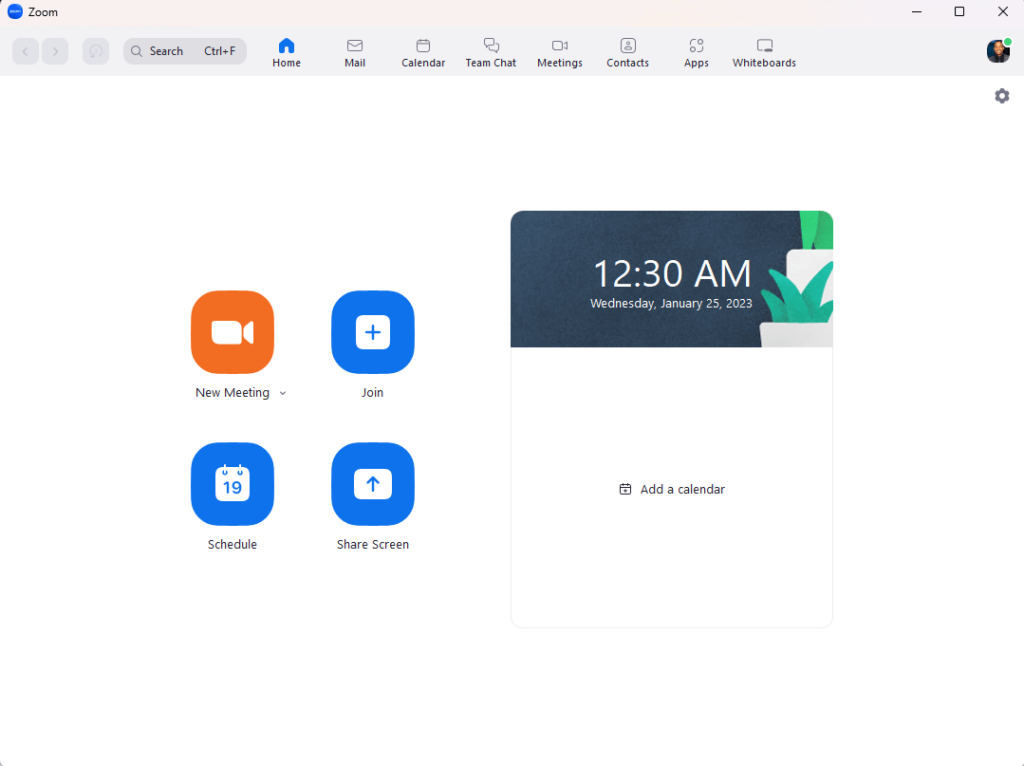
You can see that Zoom has a clean interface, with all the functions at the top bar — clear on what they mean.
A good user interface is subjective. But it’s hard to deny that Zoom’s interface is easy to understand, even for nontechie users.
For Microsoft Teams, the user interface is still easy to understand. But it might take a bit of time to understand everything.
This is what the interface of Microsoft Teams looks like:
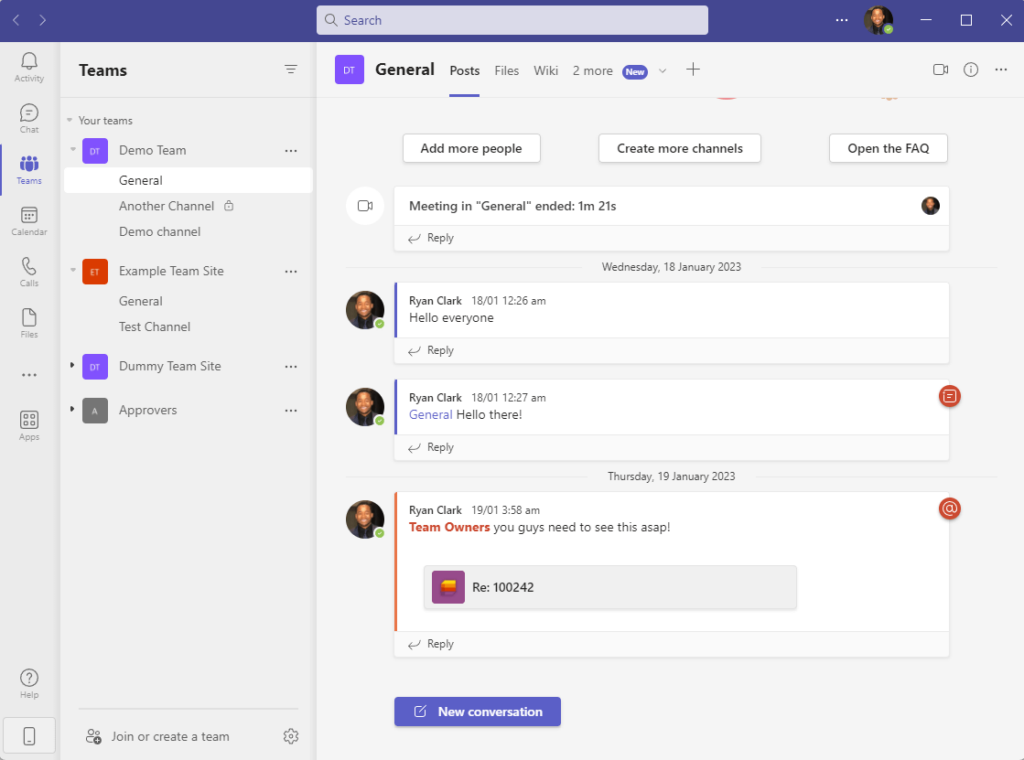
One thing that might confuse new users is the team-channel interface.
A team can have one or more channels where the actual conversation/chat takes place. Slack or Discord users may be familiar with it.
For the user interface, I would say that Zoom has an edge. Teams is a complex app so new users might need a bit of time to be familiar with it.
Note: If you want to learn Microsoft Teams asap, check this out: Microsoft Teams Tutorial: Become a Teams Expert Quickly.
2. Chat feature
Before, you need to use a separate app called Zoom Chat if you want to chat with your team outside of a video meeting.
It’s not the case anymore as the Zoom client already includes most of what you need to work together, including chat.
Zoom is slowly becoming something similar to Microsoft Teams — basically combining its many products into one platform.
This is what it looks like in action:
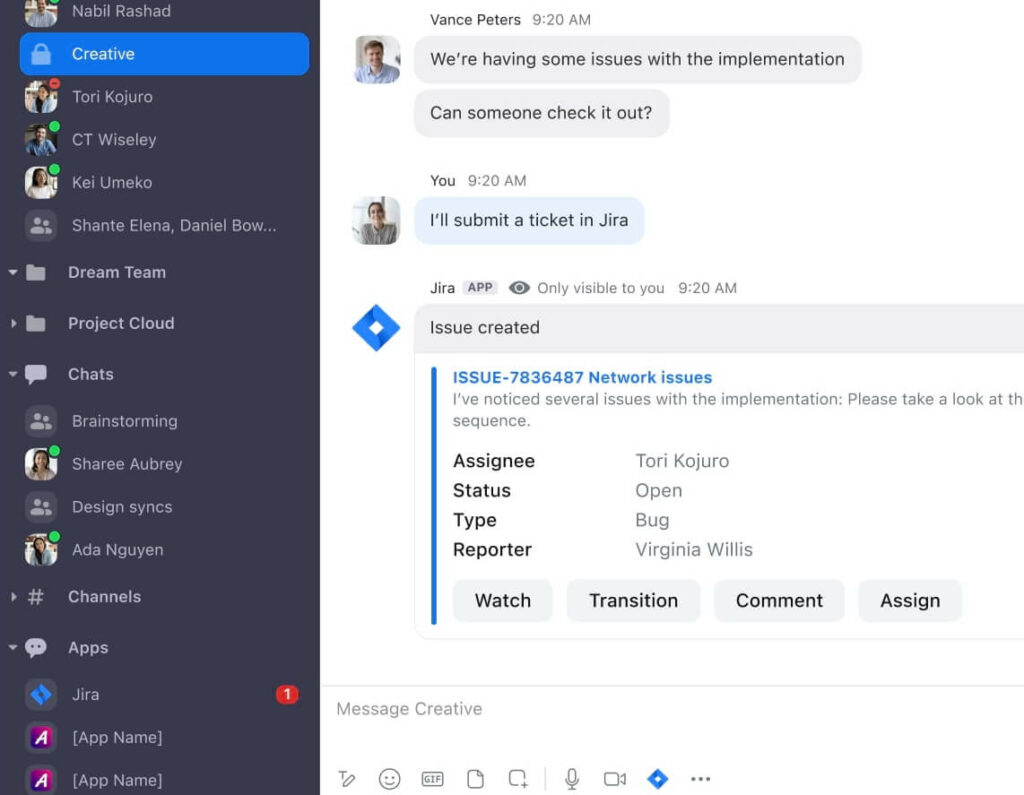
Notable features include:
- Search function
- Admin controls
- File sharing
In the case of Microsoft Teams, it got there first, so you can expect its chat features to be more advanced than what Zoom has to offer.
It looks like this:
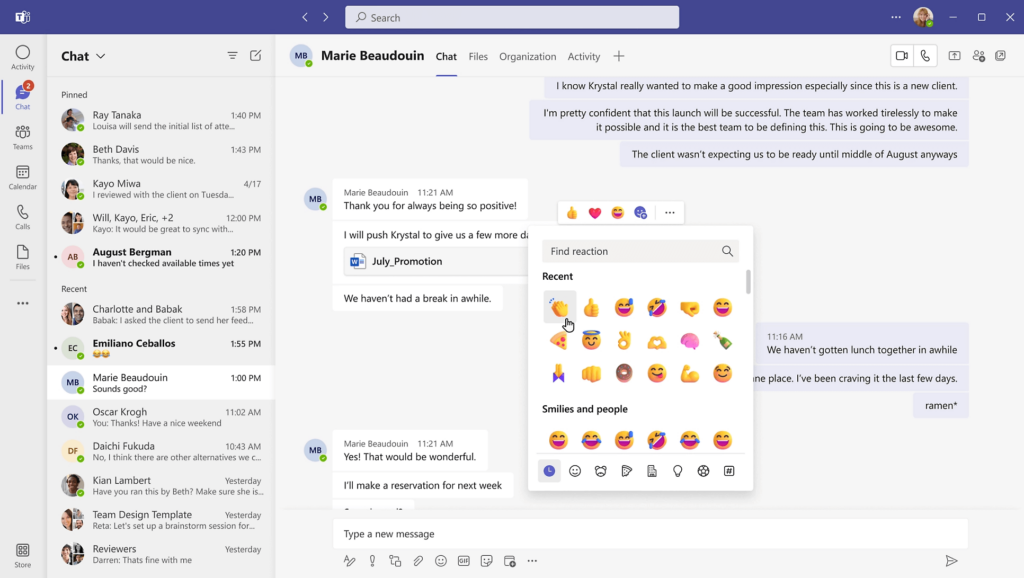
The feature has all that Zoom offers plus some more:
- Chat translation
- Rich text editing
- Priority notifications
- Schedule send
Schedule send and a few more features like suggested replies are new additions to the chat feature in Microsoft Teams.
Note: For more info on the new features, check this article: Microsoft Teams New Features 2022: Exciting Updates.
3. Video conferencing
Zoom is one of the most favorite video conferencing tools in the world — and for a good reason.
If Microsoft Teams specializes in collaboration, Zoom specializes in video conferencing. complete features like:
- Recording
- Telephone dial-in
- Screen sharing
- Breakout rooms
- Virtual backgrounds

Despite this, Zoom isn’t perfect, especially now that it has evolved.
For example, there are a lot of advanced features like recording transcripts and translated captions that are useful in video conferencing and video calls.
Unfortunately, they are only available in the most expensive plans — and this goes on for all the different aspects of Zoom.
In contrast, many of the advanced features in Microsoft Teams are available in the Microsoft 365 Business Basic plan.
These features include:
- Meeting recordings and transcripts
- Breakout rooms
- Microsoft Whiteboard

Microsoft Teams has a popular video conferencing feature geared toward using artificial intelligence to optimize video quality.
In addition, you could get full HD 1080p video quality if you’ve got good network quality, with bandwidth constraints.
Microsoft Teams also published two new features related to video calls, which are Cameo in PowerPoint Live and Together mode.
4. Room systems
If you’re unfamiliar with room systems, this simply emulates the breakout room system in face-to-face seminars and training.
Basically, it refers to the time when the host can break up the attendees into different teams and have a meeting of their own.
Zoom has breakout rooms.
By default, the host can break the meeting into as many as 50 different sessions.

To increase the capacity, the host has to contact Zoom.
The host can pre-assign breakout rooms during scheduling or do it within the meeting and can easily manage the sessions.
Participants in the breakout room can do the following:
- Select the breakout room yourself (if enabled)
- Screen sharing
- In-meeting chat
- Contact the host directly
Microsoft Teams also share similar features regarding breakout rooms.
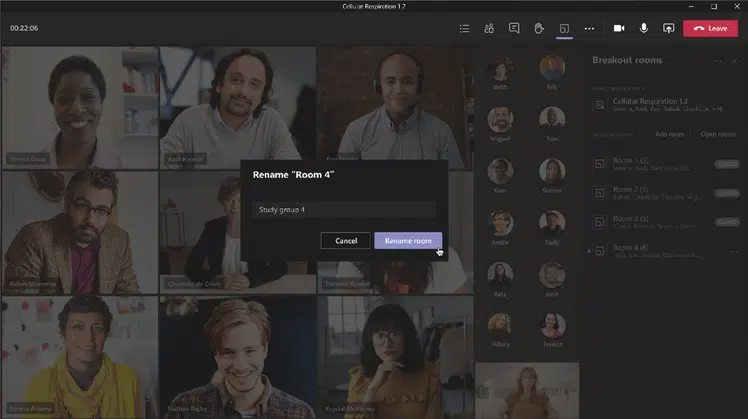
The default limit is also 50 and the organizer can automatically or manually assign people to rooms.
Because breakout rooms are primarily Teams meetings, all features and updates in the Teams app are also reflected in breakout rooms.
That means participants in a breakout room can use the together mode or bring up Microsoft Whiteboard and draw their ideas.
Unlike Zoom, however, breakout rooms aren’t available in the free version of Microsoft Teams.
5. Overall call quality and capacity
In terms of call quality, both Zoom and Microsoft Teams are on even terms.
Both could work as your go-to video conferencing app since they offer high-quality video and audio calls.
Naturally, the quality of the call will still depend on the speed, with Zoom recommending 3 Mbps and 2 Mbps for Microsoft Teams.

The only downside is that Zoom doesn’t default to 1080p, unlike Microsoft Teams which optimizes video quality.
For capacity, Microsoft Teams and Zoom offer 100 maximum participants in the free version.
Unfortunately, the differences stop there:
- The paid plan from Zoom starts with still 100 participants while for Microsoft Teams, it’s 300 participants.
- Zoom’s enterprise plus plan can support 1,000 participants, while it’s 300 participants for the Microsoft business standard plan.
- Microsoft Teams can have 20,000 listen-only participants and a live event with 10,000 participants.
6. Integrations
When it comes to integrations, things are a little hairy.
Both offer great integrations, but there are minor differences that make it important for you to consider the ups and downs.
First off, Zoom has more than 2,000 thousand integrations in the app marketplace that are available to free and paid plans.
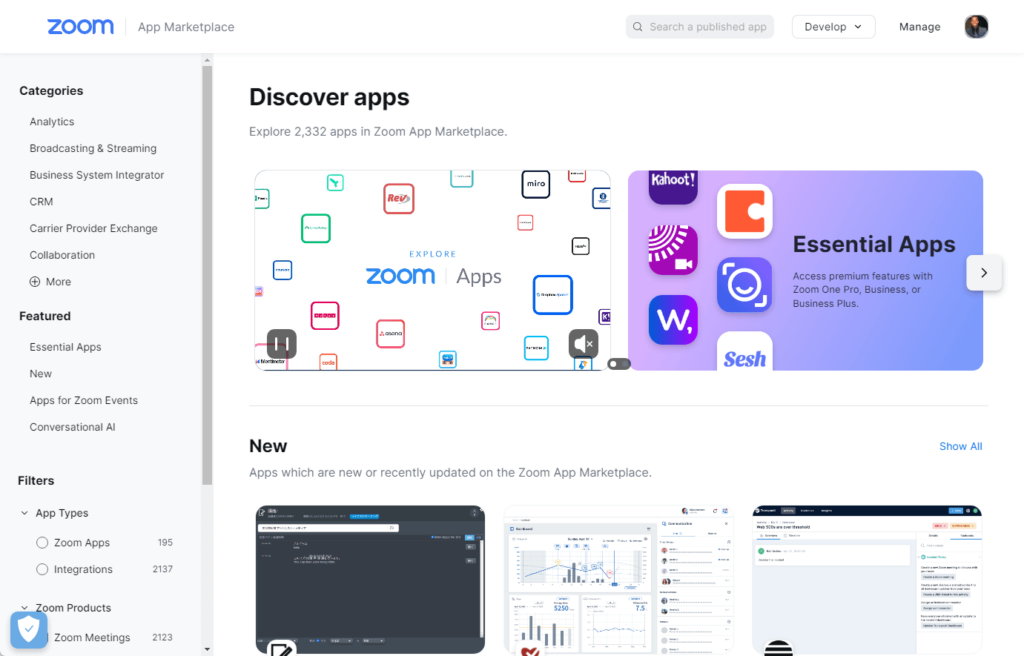
You can find apps like:
- Notion
- Slack
- Google Workspace
- HubSpot
- Calendly
There are also Zoom apps that work natively in Zoom. Think of them as third-party extensions for presentations, taking notes, etc.
Meanwhile, Microsoft Teams can integrate with more than 700 apps, with almost native integration with Microsoft 365 apps.

This might be less in number. But integration with Microsoft Teams works wonders as you’re basically bringing data into Teams.
This allows Teams users to use a third-party app right inside Microsoft Teams (don’t have to leave Teams to use apps).
You can find on Teams apps like:
- YouTube
- Jira Cloud
- Adobe Acrobat
- Trello
- Miro
- Asana
- Zoom
In terms of integration, Zoom has a lot of apps in its arsenal. But if you’re working on Microsoft 365 ecosystem, Teams is the better choice.
Related: Microsoft Teams Best Practices Guide: Focus and Management
7. Security features
In the past, security might be a touchy subject for Zoom.
Fortunately, Zoom has beefed up its security features and made it better for its users.
Zoom has the following security measures:
- 256-bit advanced encryption standard (even on screen sharing)
- Advanced chat encryption
- Optional end-to-end encryption (even Zoom can’t see your meetings)
Because of the new beefed-up security, no Zoom bombings can happen again (like what happened back in 2020).
Microsoft though has a great record when it comes to security — not to mention Microsoft is a tech powerhouse.
Microsoft Teams has the following security measures:
- Multi-factor authentication
- Session description protocol
- Media encryption
- Advanced threat protection
More features are coming like the one recently published that blocks one-on-one chat with an external user for protection.
Note: For best practices in security, read this guide: Microsoft Teams Security Best Practices: Compliance & Governance.
8. Pricing
In pricing, you will see a big difference between Zoom and Microsoft Teams.
I’ll start with what Zoom has to offer:
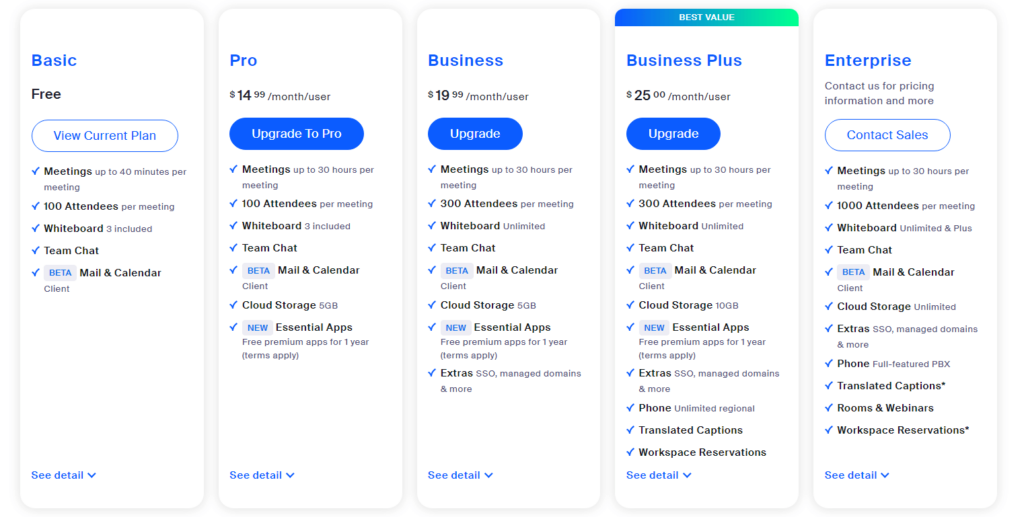
Zoom Basic (free version)
- 100 participant capacity
- Unlimited meetings with 40 minutes duration
- Local recording
- Screen sharing, breakout rooms, virtual background
Zoom Pro ($14.99 per month per user)
- 100 participant capacity
- Unlimited meetings with 30 hours duration
- Cloud recording
- Streaming, reporting, user management
Zoom Business ($19.99 per month per user)
- 300 participant capacity
- Admin portal, recording transcripts
- Language interpretations
- Unlimited whiteboards
- Custom mail domain
Zoom Business Plus ($25 per month per user)
- Similar meeting features to the business plan
- Includes phone features and phone admin features
Zoom Enterprise
- 500 participant capacity (1,000 for enterprise plus)
- Executive business reviews
- Includes webinar 500
- Phone and phone admin features
From the prices above, you can see that Zoom plans cost a lot per user per month, especially when you compare them with Microsoft Teams plans.
Microsoft Teams (free plan)
- 100 participants
- 60 minutes maxim group meeting duration
- 30 hours maximum one-on-one meeting duration
- Screen sharing, customized backgrounds, together mode, scheduled meetings
Microsoft Teams Essential ($4 per user per month)
- Unlimited group meetings for up to 30 hours
- 300 participants
- 10 GB cloud storage per user
Microsoft 365 Business Basic ($6 per user per month)
- Similar meeting features to the essential plan
- Over 30 languages of live captions
- Meeting recordings and transcripts
- Breakout rooms
Microsoft 365 Business Standard
- Everything in the business basic plan
- Desktop versions of Microsoft 365 apps with premium features
- Webinar hosting
- Attendee registration and reporting tools
Most people usually go first with the free plan from Zoom. For paid plans, Microsoft offers better packages.
Which is best for businesses?
Since I work with Microsoft apps and tools, I lean more toward Teams.
However, that’s not to say I disregard Zoom, especially user friendliness and its generous free plan.
Unfortunately, once you decide to shell out cash, Zoom’s paid plans would stare you in the eyes (plus the several upsells).
I could see that as a video conferencing tool, Zoom has better built-in features. For remote and hybrid work, Teams is still the winner.
Another way to look at it is to use Zoom for external meetings and webinars while Teams for internal meetings and conferences.
Do you prefer one over the other? What are your thoughts on these two leading productivity and video conferencing software?
For business inquiries, kindly send a message using the form here and I’ll get back to you as soon as possible.

